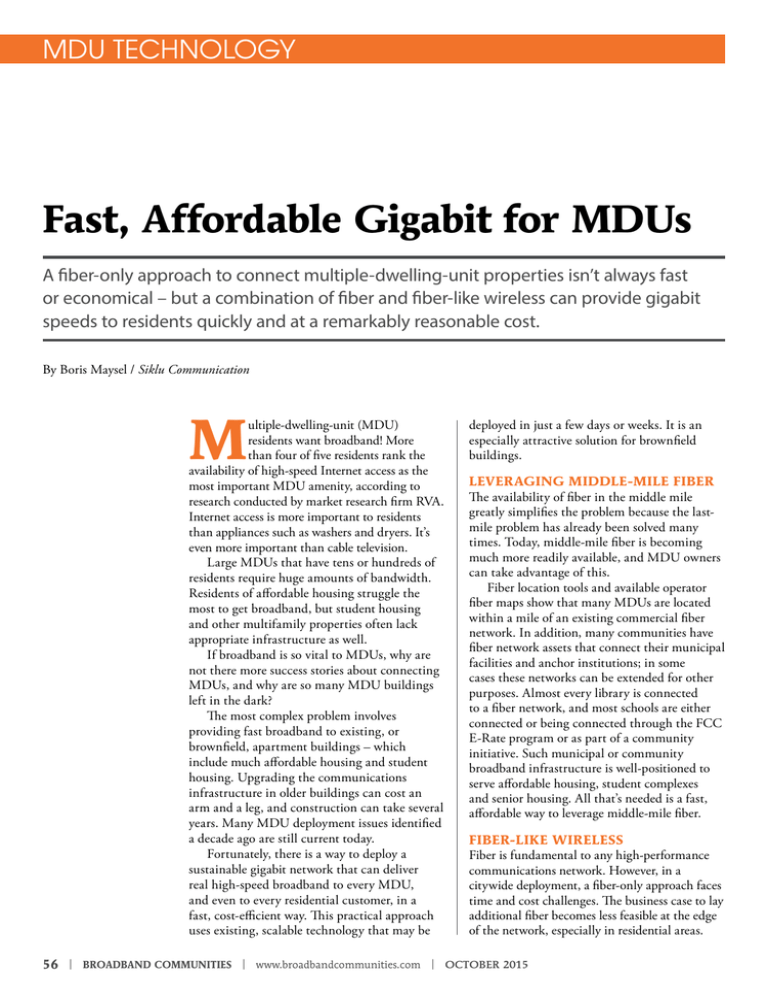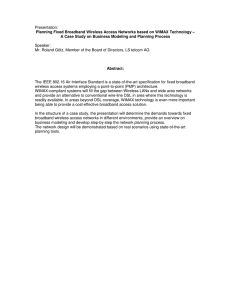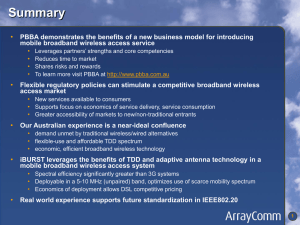Fast, Affordable Gigabit for MDUs
advertisement

MDU TECHNOLOGY Fast, Affordable Gigabit for MDUs A fber-only approach to connect multiple-dwelling-unit properties isn’t always fast or economical – but a combination of fber and fber-like wireless can provide gigabit speeds to residents quickly and at a remarkably reasonable cost. By Boris Maysel / Siklu Communication M ultiple-dwelling-unit (MDU) residents want broadband! More than four of fve residents rank the availability of high-speed Internet access as the most important MDU amenity, according to research conducted by market research frm RVA. Internet access is more important to residents than appliances such as washers and dryers. It’s even more important than cable television. Large MDUs that have tens or hundreds of residents require huge amounts of bandwidth. Residents of afordable housing struggle the most to get broadband, but student housing and other multifamily properties often lack appropriate infrastructure as well. If broadband is so vital to MDUs, why are not there more success stories about connecting MDUs, and why are so many MDU buildings left in the dark? Te most complex problem involves providing fast broadband to existing, or brownfeld, apartment buildings – which include much afordable housing and student housing. Upgrading the communications infrastructure in older buildings can cost an arm and a leg, and construction can take several years. Many MDU deployment issues identifed a decade ago are still current today. Fortunately, there is a way to deploy a sustainable gigabit network that can deliver real high-speed broadband to every MDU, and even to every residential customer, in a fast, cost-efcient way. Tis practical approach uses existing, scalable technology that may be deployed in just a few days or weeks. It is an especially attractive solution for brownfeld buildings. LEVERAGING MIDDLE-MILE FIBER Te availability of fber in the middle mile greatly simplifes the problem because the lastmile problem has already been solved many times. Today, middle-mile fber is becoming much more readily available, and MDU owners can take advantage of this. Fiber location tools and available operator fber maps show that many MDUs are located within a mile of an existing commercial fber network. In addition, many communities have fber network assets that connect their municipal facilities and anchor institutions; in some cases these networks can be extended for other purposes. Almost every library is connected to a fber network, and most schools are either connected or being connected through the FCC E-Rate program or as part of a community initiative. Such municipal or community broadband infrastructure is well-positioned to serve afordable housing, student complexes and senior housing. All that’s needed is a fast, afordable way to leverage middle-mile fber. FIBER-LIKE WIRELESS Fiber is fundamental to any high-performance communications network. However, in a citywide deployment, a fber-only approach faces time and cost challenges. Te business case to lay additional fber becomes less feasible at the edge of the network, especially in residential areas. 56 | BROADBAND COMMUNITIES | www.broadbandcommunities.com | OCTOBER 2015 In the last few years, one major breakthrough in wireless technology has been the commoditizing of millimeterwave equipment. Equipment that operates in these frequency bands can provide multigigabit capacity, is immune to interference and is suitable for deployment in dense areas. All in all, millimeter-wave wireless is a very costefective solution, particularly for the last mile. Tis approach is already widely used by wireless ISPs across the country to connect businesses in multitenantunit buildings, and it is easily scalable to residential MDUs. Adding fber-like wireless connectivity to the toolkit introduces a new paradigm to swiftly provide fber-grade services with a low investment. Te middle mile remains fber, and the last mile becomes wireless. Tis approach is called hybrid fber-wireless, or HFW. It is a hybrid topology that takes advantage of an existing fber network and utilizes state-of-the-art wireless technologies without compromising performance or reliability – and it has minimal risk. Imagine connecting every MDU within 2 miles of the fber point of presence (POP) to multigigabit speed in just a matter of days. MILLIMETER-WAVE Q&A How do millimeter-wave frequencies provide such very high capacity? Tere are actually two frequency bands called millimeter waves: the E-band and the V-band. In the United States, the E-band has 10 GHz of available spectrum (71–76 GHz paired with 81– 86 GHz), and the V-band has “only” 7 GHz of free spectrum. In fact, the V-band has more free frequencies than all the unlicensed bands put together. Tis huge amount of bandwidth enables the use of wide channels – 250 MHz, 500 MHz or even wider. Using simple modulation schemes on these channels provides true, reliable gigabit capacity – and beyond. Why are millimeter waves immune to interference? Several things happen at very high frequencies. First, according to the Friis Figure 1: Millimeter-wave signals are highly focused and thus have little interference. transmission equation (which says that signal loss is proportional to the square of the frequency), signal attenuation increases. At the same time, the antenna (for a given size) becomes more directive – that is, a higher proportion of its signal is transmitted in the desired direction, and it provides more gain. At high frequencies, as illustrated by the green band in Fig. 1, the electromagnetic signals transmitted are more focused. Interference signals that leak via antenna side lobes (unwanted radiation in directions other than the main direction) are highly attenuated both because the side lobes are small to begin with and because free space loss (overall signal attenuation) is high. As a result, there is virtually no interference in these bands, which makes them extremely suitable for deployments in dense areas. In addition, there are nine 500 MHz channels in the E-band frequencies, and with two available polarizations (diferent orientations within the same channel), network performance is rock solid. Why do millimeter-wave links cost so little? Network costs include operating expenses (opex) and capital expenses (capex). Let’s start with opex. Because millimeter-wave bands are immune to interference, no radio planning is required, and therefore there is no work for the regulator. Spectrum license fees range from very low to none. Installation is easy as well. With a proper alignment mode and simple tools, installation of a radio link can take 15 minutes. Now for the capex. Millimeterwave technology has advanced, and the old bulky, heavy, split-mount radios based on military technology have been replaced by compact, highly integrated, all-outdoor units based Millimeter-wave radios were originally developed for military applications, and they were bulky, heavy and expensive. Now they’ve been commoditized. OCTOBER 2015 | www.broadbandcommunities.com | BROADBAND COMMUNITIES | 57 MDU TECHNOLOGY Figure 2: Fiber-connected municipal anchor institutions can serve MDUs wirelessly. on commercial silicon technology. Tese outdoor units incorporate all the radio and networking components and an integrated antenna. Te small number of components and the deep silicon integration make for afordable equipment pricing. IMPLEMENTATION ISSUES Te practical approach to deploying HFW can be summarized in a single sentence: “Deploy HFW when needed; upgrade to fber when desired.” In a municipal broadband network, as illustrated in Fig. 2, fber must reach one of the municipal buildings – a school, library, hospital or fre station. From this location, the fber may be extended wirelessly to virtually any other location within a radius of up to 2 miles and with available line of sight. In this case, all buildings that comply with the above requirements will receive multigigabit speeds. Any community can use this approach to connect MDUs, provide Figure 3: Similarly, fber-connected commercial buildings can serve nearby MDUs wirelessly. multigigabit bandwidth to its residents and decrease the digital divide by serving afordable housing. In a commercial network, the role of the community anchor institution can be flled by a commercial building connected to a fber network. (See Fig. 3.) Te payback period of the fber POP in the commercial building is dramatically reduced when it is used to light a number of nearby buildings – and that makes this solution even more afordable. Te scenario shown in Fig. 3 can be implemented by fber operators or wireless ISPs, and it makes a lot of commercial sense. Te middle mile is fber, and the last mile uses wireless millimeter-wave technology. But what about end users? Because all millimeter-wave radios implement standard Ethernet ports, they can easily be connected to other in-building wiring solutions, such as • Copper, using xDSL or G.fast equipment to provide gigabit speeds • Coax, using DOCSIS protocol • Wi-Fi, which can provide indoor as well as outdoor coverage and may even be used to serve single-family homes. Te networking part of almost all the devices is standardized, which ensures interoperability and eliminates risks associated with combining diferent solutions. Either municipalities or commercial carriers can implement HFW for areas of all sizes and can deploy it in as little as a few weeks. Tis topology is feldproven, and network operators have already deployed it in many parts of the world. Afordable and relatively simple and fast to implement, HFW (combining existing fber with fber-like wireless connectivity) makes gigabit connections to the home simple, fast and afordable. v Boris Maysel is Siklu’s director of business development and is responsible for spearheading company eforts to bring gigabit throughput everywhere. Contact him at boris.m@siklu.com or 408-609-6255. 58 | BROADBAND COMMUNITIES | www.broadbandcommunities.com | OCTOBER 2015



